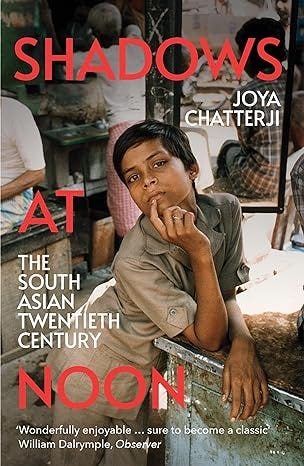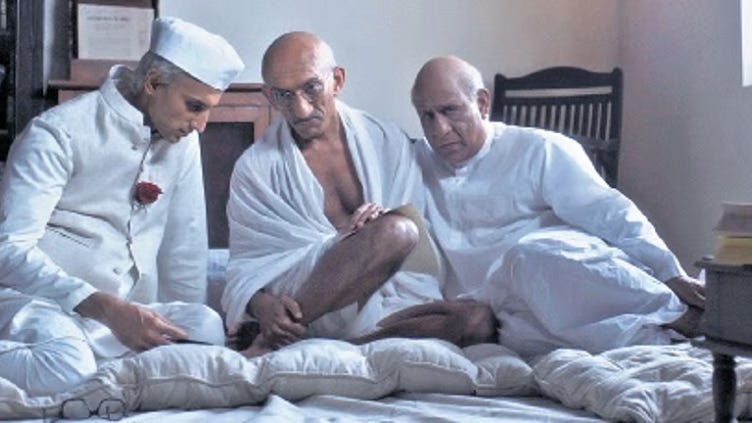Shadows at Noon: South Asia's Surprising Twentieth Century
India Tour Week 1: Competing Visions of Indian Nationalism
The World Power World History Tour is going to India and South Asia. Our guide on this eight-week dive into Indian history is Joya Chatterji, Shadows at Noon: The South Asian Twentieth Century. This week we explore the competing visions of nationalism in the first half of the South Asian Twentieth Century.
South Asia is so surprising, so fascinating, so intricate and so disturbing that I, for one, remain spellbound, still powered by the drive to understand it all. Despite knowing that such comprehension is impossible, I continue to search for it like a meal moth battering itself on a hurricane lamp. I seek light, I see shadows.
Chatterji, Shadows at Noon
My favourite historians are pluralists. They know that both the past and the present are shapeshifters who cannot be pinned down by a single story. Like Joya Chatterji, they seek lights, they find many shadows. They explore identities and discover differences.
I discovered Joya Chatterji through Shadows at Noon winning the Wolfson History Prize in 2024. It was fortuitous. I had been seeking an overview history of India that was not too academic, nor too popular; not densely chronological, nor abstractly sociological; not written from a sentimental Anglo-American perspective, nor a combatively nationalist viewpoint; not only political history, nor culture abstracted from social life. Shadows at Noon was a perfect fit.
I made this book therefore the focus of the India leg of the World History World Tour. Over the next eight weeks, we will do a ‘slow read’ of this one book, and I will spice the dish with weekly book recommendations that offer other perspectives. Each post will give you a glimpse into the South Asian Twentieth Century. You will gain so much more, however, by reading Chatterji’s book alongside these weekly posts.
I highly recommend you buy this book which you can do here.
Reminder to all subscribers: From this week I am integrating the weekly book recommendation and deep dive into a single post on Saturday. I set out the program for this India tour in my post last week. This new approach aims to improve your reading experience. Your inbox will be less cluttered and you get a whole week’s worth of quality history in one package.
I also sought a book to explore the idea of India as a “civilization-state” whose power was growing in a multi-civilizational world. I use these terms with caution, and for convenience, because I know that these terms conceal a deeper truth: like the ‘West’, like Europe, like our personal selves, India does not have one ‘civilizational’ identity. India is large. India contains multitudes.
That surprising, fascinating, intricate, and disturbing plurality is the theme of Chatterji’s book. Chatterji ignores the idea of a “civilization-state,” which is a term she does not use. She questions the hold of states or national identities over people’s lives. She does not doubt that leaders and nations aspire to be “civilization-states” or to imprison their plural potential in a claim of nationhood. “But,” Chatterji writes, “trying to control people is one thing; succeeding is another.”
Still, the states of South Asia in the twentieth and twenty-first centuries seek to persuade their citizens to identify as three separate nations or grander civilizations, and even to fight wars or conduct terror for those ideas.
“Making citizens identify with their nation’s self-declared character and ambition has dominated South Asian politics for the latter half of the twentieth century. It remains an ongoing project, hotly contested in all three countries, since there is no unanimity about what each nation’s character really is. It was ever thus: there never was harmony among nationalists, nor among new rulers. Nonetheless citizens were produced in their millions.”
Chatterji, Shadows at Noon, p. xvi
Before that project began, when India and Pakistan formed as independent nations in 1947, there was a furious debate, and at times a violent struggle, over the competing visions of “nation” and its differences from empire, state, or community. That contest from the Indian Mutiny of 1857 to the Partition of 1947 is the subject of the first chapter of Shadows at Noon, “Competing Visions in the Age of Nationalisms.”
A Second Opinion on Indian Nationalism
Before I dive into this chapter, let me offer my weekly history reading recommendation.
The Stanford-based, South Asian historian Priya Satia presents a complementary perspective on the same debate, focussed on how Jawaharlal Nehru, first Prime Minister of India from 1947 to 1964, navigated competing visions of nation, before and after Independence. This article, Nehru’s Other Indias, is freely available and is an edited version of Satia’s Nehru Memorial Lecture 2024, which you can watch here.
Nehru continued to fashion his ideas about leadership from British influences even while in prison by the British in that time. . . . One wonders if Tagore had Nehru in mind in 1941 when he warned Indian nationalists against modeling themselves on “Garibaldis and Washingtons,” as this, in his mind, only further entrenched the European norms from which they sought recovery.
Priya Satia, Nehru’s Other Indias (2024)
I have written previously on Satia’s ideas of political communities beyond nation and plural histories of redemption. I have also done audiobook minis of Tagore’s essays On Nationalism (1917) and the Crisis of Civilizations (1941), in which, composed months before his death, he warned Nehru against emulating Euro-American nationalism. These essays are well worth reading or listening to during the week.
Content Catch-up
You might also want to catch up on my content over the last week.
On Monday I concluded the Slow Read of The Books of Jacob with the Final Chapter. Don’t be shy about sending me comments or questions ahead of Monday’s Livestream (10:00 AM AEST +10UTC, Monday 7 July).
What comment or question would you like to ask me about the book, the author, the history, or the Books of Jacob slow read experience? I will answer them in Monday’s live stream.
My video, How to undo the USA empire, slowly, asked if the USA Empire keeps launching endless wars, how should the world respond?
My video, Why India China Relations Will Shape the Next Decade of Global Politics explained why the most critical geopolitical relationship is not USA-China; it is India-China.
My video, Historian reveals the Surprising Real History of the Post-1945 World, completed my series on the Rise and Fall of Global Empires 1400-2000. It comes out late afternoon Saturday 5 July.
This video summarises key points from my Post-1945 World | The Real History Guide, which is available for paid subscribers.
Following a suggestion by a subscriber, I will shortly post the transcripts of my interviews with historians to the my Substack page.
Do check out my most recent interview with the great Australian historian of the Soviet Union and Russia, Sheila Fitzpatrick.
Many thanks to all my subscribers, paid and unpaid, for supporting me in this fantastic journey through history. I hope it helps you to live in tune with a changing world. Please consider upgrading your subscription to get more from my guides, deep dives, and slow reads.
Below, my guide to “Competing Visions in the Age of Nationalisms,” Shadows at Noon.






